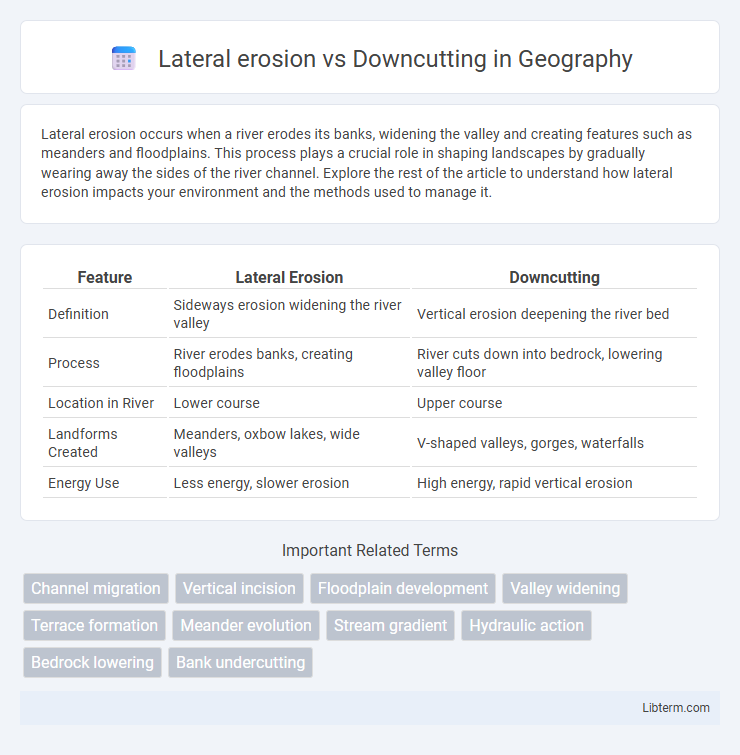Lateral erosion occurs when a river erodes its banks, widening the valley and creating features such as meanders and floodplains. This process plays a crucial role in shaping landscapes by gradually wearing away the sides of the river channel. Explore the rest of the article to understand how lateral erosion impacts your environment and the methods used to manage it.
Table of Comparison
| Feature | Lateral Erosion | Downcutting |
|---|---|---|
| Definition | Sideways erosion widening the river valley | Vertical erosion deepening the river bed |
| Process | River erodes banks, creating floodplains | River cuts down into bedrock, lowering valley floor |
| Location in River | Lower course | Upper course |
| Landforms Created | Meanders, oxbow lakes, wide valleys | V-shaped valleys, gorges, waterfalls |
| Energy Use | Less energy, slower erosion | High energy, rapid vertical erosion |
Introduction to Fluvial Erosion
Fluvial erosion shapes river landscapes through two primary processes: lateral erosion and downcutting. Lateral erosion widens river valleys by eroding the banks, creating floodplains and meanders, while downcutting deepens the riverbed, forming features such as canyons and gorges. Understanding the balance between lateral erosion and downcutting is essential to analyzing river dynamics and sediment transport in fluvial geomorphology.
Defining Lateral Erosion
Lateral erosion refers to the sideways wearing away of a riverbank or valley wall, primarily occurring in the middle and lower courses of a river where the flow velocity is slower and meanders develop. It contrasts with downcutting, which involves vertical erosion that deepens the riverbed, typically dominant in the upper course with steeper gradients and faster flow. Lateral erosion shapes features such as floodplains and river terraces by widening the valley rather than deepening it.
Understanding Downcutting (Vertical Erosion)
Downcutting, or vertical erosion, primarily deepens river valleys by removing sediment from the streambed, resulting in the formation of V-shaped valleys and steep channel profiles. This process is driven by the river's kinetic energy and gradient, which dictate its ability to erode downward rather than sideways. Downcutting plays a crucial role in landscape evolution, particularly in youthful river stages where vertical incision dominates over lateral erosion.
Key Differences Between Lateral Erosion and Downcutting
Lateral erosion primarily occurs along the sides of a river channel, widening the valley and creating features such as floodplains and meanders, whereas downcutting involves the vertical deepening of the riverbed, resulting in the formation of V-shaped valleys and canyons. Lateral erosion dominates in mature river stages with gentle slopes, while downcutting is more active in youthful rivers with steep gradients. The distinct geological impact of lateral erosion includes the expansion of riverbanks, whereas downcutting shapes the landscape by lowering the riverbed and increasing channel depth.
Geological Processes Involved
Lateral erosion primarily involves the widening of river valleys as water flow erodes the banks through hydraulic action and abrasion, shaping meanders and floodplains. Downcutting, or vertical erosion, deepens the riverbed by removing sediment and rock layers, driven by the river's kinetic energy and gradient steepness. These geological processes influence landscape evolution by controlling valley morphology and sediment transport dynamics.
Impact on River Channel Shapes
Lateral erosion predominantly widens river channels by eroding the banks, creating meanders and floodplains, while downcutting deepens the riverbed, leading to V-shaped valleys and steep channel profiles. The balance between these processes dictates the river's morphology, with lateral erosion promoting sinuous, broader channels and downcutting producing incised, narrow valleys. Understanding this dynamic is crucial for predicting changes in river landscapes and managing sediment transport effectively.
Influence on Landscape Formation
Lateral erosion predominates in the middle and lower courses of rivers, widening valleys and creating floodplains, while downcutting mainly occurs in the upper courses, deepening river channels and forming V-shaped valleys. The balance between lateral erosion and downcutting shapes river morphology, influencing features such as terraces, meanders, and gorge development. Over time, these erosion processes dictate landscape evolution, impacting sediment distribution and watershed characteristics.
Factors Affecting Erosion Rates
Lateral erosion primarily depends on river discharge, sediment load, channel slope, and bank material resistance, with higher discharge and softer banks accelerating erosion. Downcutting is influenced by base level changes, gradient steepness, rock type, and sediment supply, where increased gradient and lower base level intensify vertical incision. Variations in climatic conditions and vegetation cover also play crucial roles in modifying both lateral erosion and downcutting rates.
Real-World Examples of Lateral Erosion and Downcutting
Lateral erosion prominently shapes meandering rivers such as the Mississippi River, where the riverbank erodes sideways, broadening the valley and creating wide floodplains. Downcutting is evident in the Grand Canyon, where the Colorado River has vertically eroded the landscape over millions of years, deepening the canyon and exposing geological layers. These contrasting processes demonstrate how rivers sculpt their environments either by widening their courses through lateral erosion or deepening valleys via downcutting.
Summary and Environmental Implications
Lateral erosion occurs along the sides of a river channel, widening the valley and creating floodplains, while downcutting deepens the riverbed, forming steep banks and canyons. These processes influence sediment transport, habitat diversity, and floodplain connectivity, affecting ecosystems and human land use. Environmental implications include increased risk of erosion and habitat loss from downcutting, whereas lateral erosion promotes nutrient-rich soils but can lead to property damage and altered water flow patterns.
Lateral erosion Infographic

 libterm.com
libterm.com